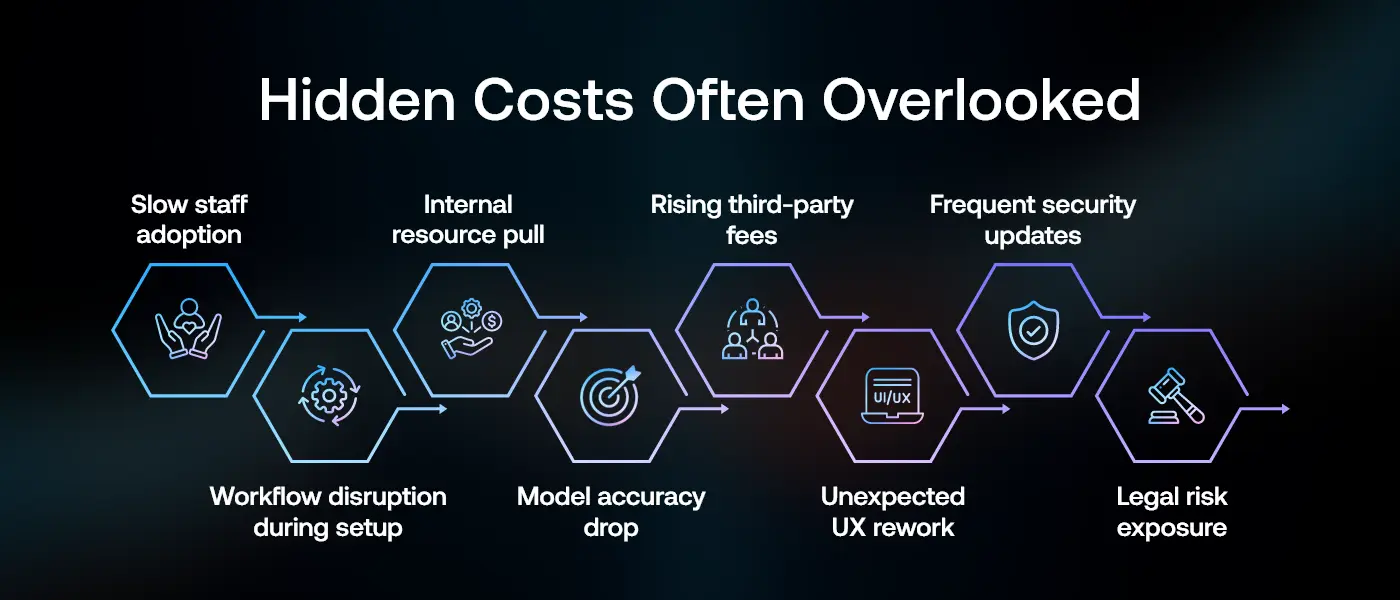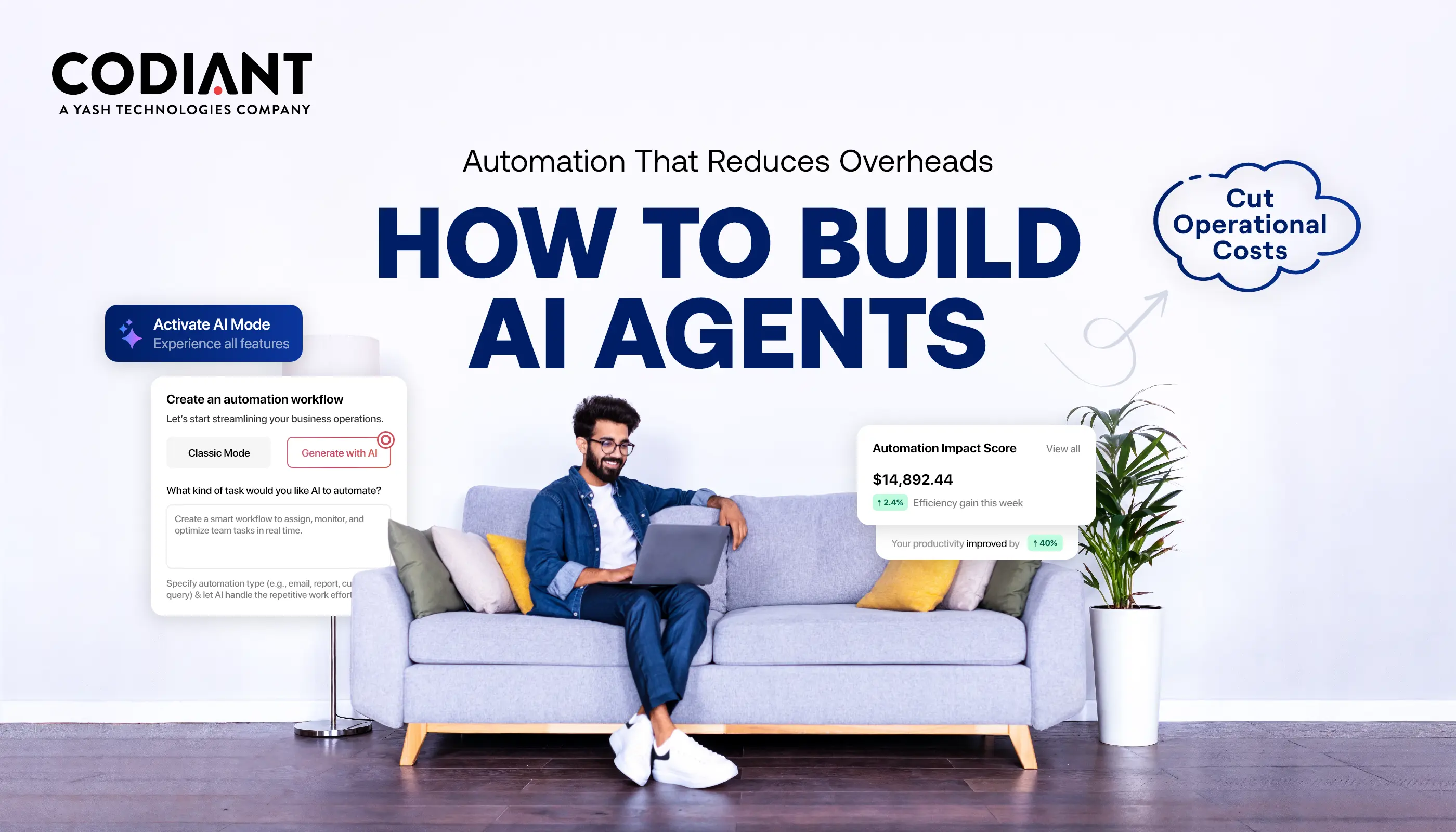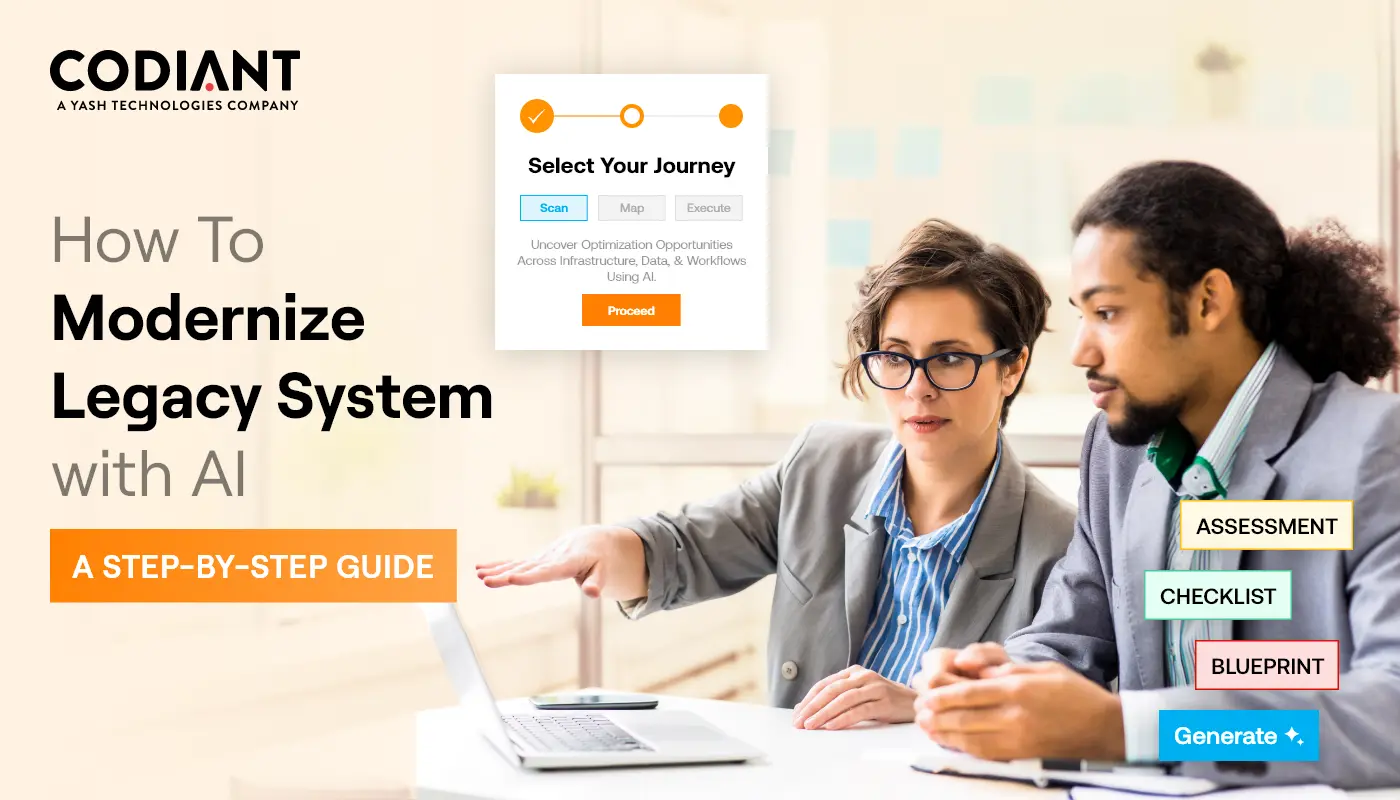The Cost of AI in Healthcare: Crucial Factors to Evaluate
Table of Contents
Subscribe To Our Newsletter

Everyone’s talking about AI in healthcare. But no one’s talking about the bill.
Sure, AI can spot diseases before symptoms show. It can assist surgeries, decode mountains of medical data, and even predict patient outcomes with uncanny accuracy. Sounds like magic. But magic, as we know isn’t free.
Behind every “AI breakthrough” headline is a silent, growing question: How much does it really cost to build, run, and scale Artificial Intelligence in healthcare Industry? And more importantly – what’s the cost of getting it wrong?
Is the price only in dollars? Or in downtime, integration chaos, patient trust and ethical minefields?
This isn’t just a budget issue – it’s a strategic one. Before jumping on the AI train, healthcare leaders must ask the right questions, peel back the hype and understand the full spectrum of cost drivers.
Because in healthcare, decisions don’t just affect operations – they affect lives.
Ready to decode what AI truly costs in this high-stakes industry? Let’s begin.
Why Healthcare Organizations Are Investing in AI
It’s not just about being future-ready. It’s about survival.
Hospitals today are overwhelmed – with rising patient volumes, physician burnout, aging infrastructure, and a never-ending demand for better outcomes at lower costs. Traditional systems are simply not built to keep up.
Enter AI – not as a replacement but as a force multiplier.
Healthcare organizations are turning to AI for one simple reason: they can no longer afford not to AI helps automate administrative grunt work, accelerate diagnoses, streamline resource allocation and even forecast patient deterioration hours before it happens.
But it’s not just clinical gains. Leaders see AI as a strategic lever – to reduce operational inefficiencies, shorten billing cycles, improve staff productivity and unlock entirely new revenue streams through remote care and predictive models.
In an healthcare industry where margins are tight and expectations are sky-high, AI implementation in healthcare is becoming the backbone of competitive advantage.
And those who invest now? They’re not just optimizing care – they’re future-proofing their business.
Did You Know?
As of 2025, over 63% of large healthcare providers in the U.S. have integrated at least one AI solution into their clinical or administrative workflows. That’s a massive jump from just 23% in 2020.
Initial Development vs. Long-Term AI Cost
Buying AI is easy. Owning it? That’s where the real cost begins.
Most healthcare leaders go into AI projects with a rough idea of what the initial build might cost. But very few are fully prepared for what happens after go-live. From maintenance and retraining to compliance and scaling—costs stack up in places that don’t always show up in the proposal.
Let’s break it down.
1. Development Cost: Setting the Foundation
Initial development costs typically include everything from data acquisition to regulatory readiness. Here’s a breakdown:
| Component | Estimated Cost Range |
|---|---|
| Data Collection & Cleaning | $50,000 – $200,000 |
| AI Model Development & Training | $100,000-$500,000 |
| Infrastructure Setup (Cloud, Security) | $75,000-$300,000 |
| System Integration (EHRS, APIs, etc.) | $50,000-$250,000 |
| Compliance & Regulatory Certifications | $100,000-$400,000 |
| Total Estimated Development Cost | $375,000-$1.65 million |
These costs vary widely depending on the complexity of the use case – e.g., clinical diagnostics vs. administrative automation – and the regulatory burden of the target market (e.g., U.S. vs. EU vs. APAC).
2. Long-Term Cost: Sustaining the Value
Once deployed, AI systems require constant upkeep to remain accurate, secure and compliant. Long-term costs include:
| Ongoing Component | Estimated Annual Cost |
|---|---|
| Model Maintenance & Re-training | $50,000-$150,000/year |
| Cloud & Storage Scaling | $40,000-$120,000/year |
| IT Support & Monitoring | $30,000-$100,000/year |
| Staff Training & Change Management | $20,000-$75,000/year |
| Legal & Regulatory Updates | $25,000 – $80,000/year |
| Total Estimated Annual Cost | $165,000-$525,000/year |
These recurring costs are often underestimated, but over a 5-year span, they can exceed the original development budget. Additionally, any expansion – adding departments, hospitals or use cases – further scales these costs.
Takeaway:
It’s easy to underestimate the full cost of AI in healthcare. What looks like a one-time tech investment is actually an ongoing financial commitment. Smart organizations factor in the lifecycle cost – so their AI strategy is not just innovative but sustainable.
Critical Cost Factors to Evaluate
There’s more to AI cost than just development hours or hosting fees. It’s the layers underneath that quietly add up. Every decision – from how you handle patient data to who builds your model – affects the total cost. And in healthcare, where compliance, safety & accuracy matter more than speed, these cost factors can become deal-breakers if overlooked.
Let’s walk through the real-world drivers that often shape the budget behind AI in healthcare.
1. Data Quality and Annotation
No matter how advanced the model is, if the data going in is flawed the results will be too. In healthcare, data can be scattered across departments, stored in outdated systems or full of missing and inconsistent values. Cleaning all that up takes time. Add to that the fact that most training data needs to be labelled – and in many cases, by medical professionals – and you’re looking at a serious investment just to prep your AI for learning.
Reality check: Annotation by qualified experts doesn’t come cheap. And if your use case involves radiology scans, ECGs or clinical notes, the costs shoot up fast.
Cost impact: If your model relies on clinical images or unstructured notes, expect to pay $5 – $20 per data point for expert annotation. For large datasets this can easily cross $100K+ just in labeling.
2. Regulatory & Compliance Requirements
This is where healthcare really sets itself apart from other industries.
If your AI tool touches anything diagnostic, there’s a good chance you’ll need FDA approval or other regional certifications. Even non-diagnostic tools need to follow HIPAA, GDPR & interoperability standards like HL7 or FHIR.
These are not just checkboxes – they require real effort, documentation & sometimes legal support.
Bottom line: Compliance is not optional and it’s not cheap. It is a built-in cost that has to be planned from day one.
Cost impact: Depending on the use case and region, getting through approvals & audits can cost anywhere from $100K to $500K plus internal time spent on documentation, testing and legal reviews.
3. Technology Stack & Integration
You may have a great AI model, but if it does not integrate well with your legacy systems then it is useless. But tech environments in most hospitals are very heterogeneous – legacy EHRs, cloud apps and homegrown programs all running in parallel.
It takes work to get your AI solution working against this patchwork. You have to choose between using third-party APIs (faster but more expensive in the long run) or developing a custom integration in-house (slower but more control).
In either case, integration is not a one-time event. Your AI setup requires continual testing, fixes and support whenever systems update or scale.
Integration ongoing cost: Integration work can range from $50K-$250K depending on how deep the integration is between systems. And this does not account for maintenance or future system upgrades.
4. Talent & Expertise
You can’t build AI with generalists. And in healthcare you need a very specific mix – AI engineers, data scientists, clinicians, product folks and sometimes even legal advisors.
Finding people who understand both the tech and the medical context isn’t easy. Retaining them is even harder.
What to expect: Salaries are high, and onboarding time is real – especially when aligning teams from both tech and healthcare sides.
Cost impact: Salaries for top AI talent often start at $120K–$200K/year. Add part-time consultants, onboarding and domain specialists, and your team cost can climb fast – especially in the early phases.
5. Customization for Medical Specialties
AI isn’t one-size-fits-all. What works for dermatology won’t work for mental health. Even within the same specialty, different hospitals or regions may have different protocols or data formats.
That means retraining models, adjusting logic, tweaking interfaces – all of which take time, money and domain knowledge.
Good to know: Even if the backend is shared, each specialty often needs its own UI, patient flow and validation layers. That adds up fast.
Cost impact: Customizing for specialties typically increases project costs by 30–50%, especially when clinical UX or patient-facing interfaces need to be tailored from scratch.
6. Security & Risk Mitigation
AI systems can drift over time – meaning their predictions get less accurate as data patterns change. And let’s not forget the risk of security breaches when handling sensitive patient data.
To stay on top of this, you’ll need explainability tools, monitoring systems and clear audit trails. Not just to keep things safe, but to keep regulators and clinicians confident in the system.
Worth noting: This is one of the most overlooked costs. But when something goes wrong – this is the piece that protects you.
Cost impact: Building in these safety layers can add another $50K–$150K to your budget. But skipping them? That could cost you a lawsuit or regulatory fine down the line.
Hidden Costs Often Overlooked

Some costs don’t show up in the budget – but they hit hard once the system goes live. Here’s what usually catches teams off guard:
- Training staff takes longer than planned especially when workflows change and resistance kicks in.
- During integration the system might slow down or glitch a little especially with older EHRs.
- Internal teams like doctors or compliance folks get pulled in for testing and validation on top of their day jobs.
- Over time AI models lose accuracy so you’ll need to monitor and retrain to avoid bad predictions.
- Third-party tools or APIs often come with monthly fees that grow as more users or features get added.
- After go-live you’ll get real user feedback and most times you’ll need to tweak the interface or flow.
- Regular security patches are a must especially when you’re handling sensitive health data on cloud systems.
- Legal risks are real if AI makes a wrong call so you’ll need a backup plan just in case.
Case Study Snapshot: AI in Radiology
How AI –Powered Healthcare Solutions Helped Cut Diagnosis Time by 30% in a Mid-Sized Hospital
A 250-bed hospital that implemented an AI-powered radiology tool to assist with reading chest X-rays. Before adopting AI, radiologists were overwhelmed with hundreds of scans daily, often resulting in delays and fatigue-related errors.
After deploying an AI solution trained to detect anomalies like pneumonia, nodules & fractures, the hospital observed significant improvements in workflow and cost efficiency.
Before vs. After AI Implementation – Quick Breakdown
| Metric | Before AI | After AI |
|---|---|---|
| Average time per diagnosis | 12 minutes | 8 minutes (+ 30%) |
| Daily cases processed per radiologist | 40-45 | 60-65 (+45%) |
| Staff fatigue and error rate | High (approx. 6% error rate) | Reduced to under 2% |
| Manual double-checks required | 100% | Only 20-30% cases needed review |
| Estimated monthly labor cost | $18,000 | $14,000 (~$4,000 saved/month) |
| Patient report turnaround time | 24-36 hours | 12-18 hours |
Key Takeaway:
By investing in an AI diagnostic assistant for radiology, the hospital not only sped up diagnosis by 30% but also cut monthly labor costs by over 20%, reduced errors & improved overall patient care speed. While the initial AI deployment cost was around $70,000 the hospital recovered that investment in just over 18 months through cost savings & operational efficiency.
Read more: Healthcare Chatbots Development – AI Features, Use Cases & Benefits
Cost Comparison Between Proprietary and Open-Source Solutions
The high-level strategic choice here in assessing the cost of AI in healthcare is between open-source frameworks and proprietary AI solutions. Each option has its own cost structure, advantages and long-term ramifications – and particularly with respect to ROI scalability & customization.
Key Takeaways: Open-Source AI Tools – Cost-Effective But Resource-Intensive
Free libraries for building AI models like TensorFlow, PyTorch and MONAI (Medical Open Network for AI) allow researchers to build AI models more easily than ever without requiring costly licensing fees. They are open-source have community support & can be completely modified for some healthcare applications – building models for radiology images or pathology.
However, the “free” tag can be misleading. Open-source tools require:
- In-house AI expertise to develop and maintain models
- Time-intensive data preparation and annotation
- Continuous optimization to maintain performance and accuracy
- Integration costs to connect with existing EHR, PACS or LIS systems
In essence, while open-source reduces licensing costs it shifts the burden to human capital and operational investment. It’s ideal for healthcare organizations with a skilled internal tech team and a strong R&D budget.
Proprietary AI Vendors: Higher Upfront, Faster ROI
On the flip side, proprietary healthcare AI solutions – like IBM Watson Health (now Merative), Aidoc or Tempus – come with a price tag but also deliver plug-and-play functionality. These platforms offer:
- FDA-cleared and HIPAA-compliant models
- Pre-trained AI for specific medical use cases
- Built-in integrations with hospital systems
- Ongoing support and maintenance
While the upfront licensing and subscription fees may be significant, many providers see a faster time-to-value, improved compliance and reduced deployment risk. It’s a good choice for hospitals that want reliable, production-ready AI without building from scratch.
Build vs. Buy: What’s Right for You?
Choosing between open-source and proprietary ultimately comes down to your organization’s priorities:
- Build (Open-source) if you need full control, have unique use cases & have internal AI expertise
- Buy (Proprietary) if you want faster deployment, compliance readiness & ongoing vendor support
Some healthcare systems adopt a hybrid approach – starting with open-source for prototyping and switching to commercial platforms for scalability.
Read More: AI Voice Bots in 2025: A Complete Guide & How to Use Them
How to Control and Optimize AI Costs
Adopting AI in healthcare doesn’t have to mean breaking the bank. With smart planning & the right strategies, organizations can keep costs under control while maximizing value. Here are four effective ways to manage AI expenses:
| Strategy | What It Means | How It Helps Reduce Costs |
|---|---|---|
| Phased AI Implementation with Pilot Testing | Start small with a test project before rolling AI out across the whole system. | Avoids large upfront investment, lets you fix issues early, and proves ROI before scaling. |
| Cloud Cost Monitoring Tools (e.g., AWS Cost Explorer, Azure Cost Management) | Use built-in tools from cloud platforms to track usage, set budgets, & get alerts. | Prevents surprise bills, helps teams monitor spending in real time, and optimize cloud usage. |
| Using Synthetic Data for Early-Stage Testing | Create realistic, artificial data sets instead of using real patient data for model training. | Cuts data acquisition and annotation costs; avoids privacy risks and speeds up model testing. |
| Partnering with Experienced AI Development Firms | Work with companies who specialize in building healthcare AI tools. | Saves time and money compared to building in-house; benefits from domain knowledge and tools. |
Final Thoughts: Is AI in Healthcare Worth the Investment?
Let’s bring it full circle.
By now, you’ve seen that the cost of AI in healthcare isn’t just one big number. It’s a mix of line items—data acquisition, compliance, tech stack, training, integration, and more. And yes, some of them can quietly balloon if you don’t track them from day one. That’s where CalCounts can help streamline data insights and optimize healthcare efficiency through intelligent tracking and analysis.
But remember – AI is only expensive when implemented without a strategy.
If you’re clear on what problem you’re solving,
If you’ve budgeted for both development and post-launch maintenance,
And if you’ve chosen tech that plays well with your current systems…
…then AI becomes a cost optimizer, not just a cost center.
Most failed AI projects in healthcare don’t flop because the tech is bad. They fail because the cost structure wasn’t planned end-to-end. Due diligence is everything.
So, is AI worth it?
If you evaluate it the right way—absolutely.
But skip the crucial cost factors, and it could burn a hole in your budget.
Want to implement AI in your hospital without overspending?
Get expert guidance to plan, budget, and optimize your AI investment smartly.
Let’s Talk AI
Frequently Asked Questions
It depends on what you’re building – some AI tools start at $20K, while full custom solutions can go over $200K. The more complex the task, the higher the cost.
Yes, but start small. Tools like AI chatbots or appointment schedulers are affordable and help you save time and money quickly.
Because it needs clean medical data, expert training, and must follow strict rules like HIPAA. You’re not just paying for tech – you’re paying for trust and safety too.
Ongoing updates, staff training, cloud fees & integration with existing systems. These often get missed in the initial budget.
Some tools show results in weeks, others in months. But the key is to measure early & keep improving. AI isn’t magic – it needs real-world tuning.
Featured Blogs
Read our thoughts and insights on the latest tech and business trends
Learn How to Build AI Agents That Can Speed Up Your Work and Reduce Other Expenses
- November 10, 2025
- Artificial Intelligence
Businesses today are looking for faster ways to work and smarter tools that cut costs. That’s why AI agents are quickly becoming a key investment for companies of all sizes. These autonomous systems can perform... Read more
How to Build a Logistics and Transportation App Like Aramex?
- November 6, 2025
- Logistics & Transportation
In a Nutshell: A logistics app like Aramex helps businesses manage deliveries, track shipments, and serve customers better. Technology is now needed in logistics because customers want fast delivery and real-time tracking. A logistics app... Read more
How to Modernize Legacy Systems with AI – A Step-by-Step Guide
- October 31, 2025
- Artificial Intelligence
In a Nutshell: Legacy systems aren’t outdated - they’re underutilized. AI can modernize them without full replacement, saving time and cost. Modernization is a journey, not a rebuild. Start small with automation, data clean-up &... Read more





